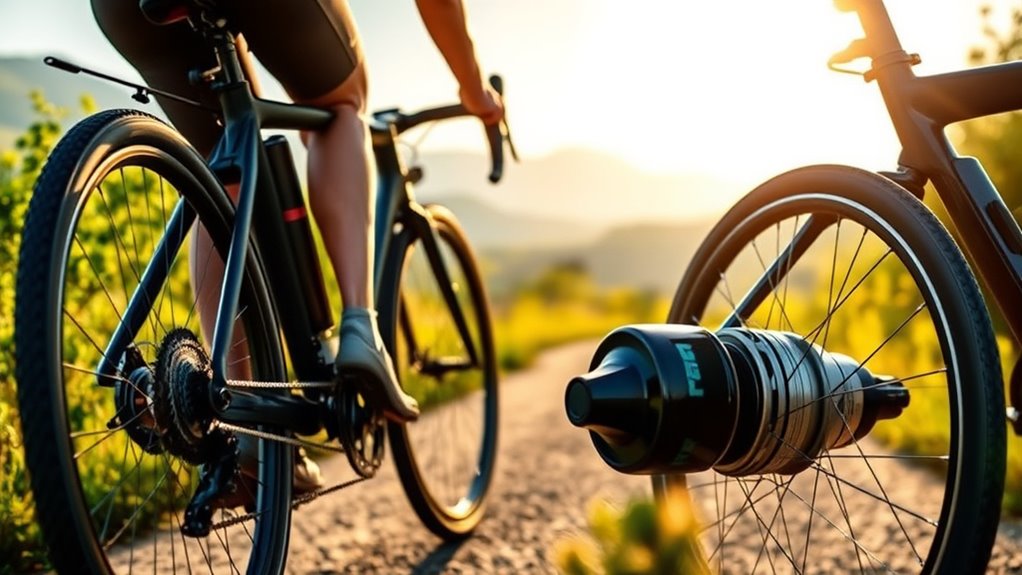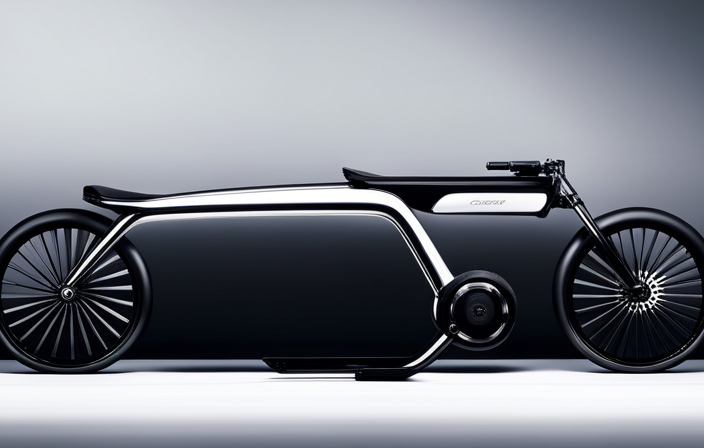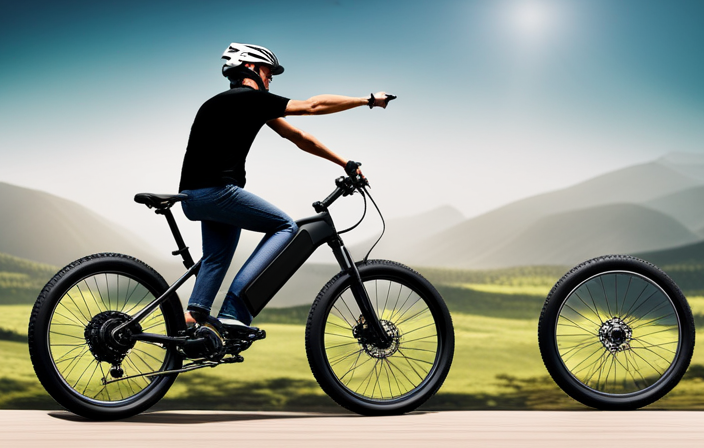If you’re choosing between mid-drive and hub motors, consider your riding style and terrain. Mid-drive systems offer better handling, efficiency, and performance on hills, but they tend to cost more and need more maintenance. Hub motors are simpler, more durable, and great for flat urban rides. To make the best decision for your needs, keep exploring the key differences and advantages each system provides.
Key Takeaways
- Mid-drive motors offer better weight distribution, handling, and performance on hilly or rugged terrains.
- Hub motors provide simpler maintenance, stability, and are ideal for flat, urban riding environments.
- Mid-drive systems deliver higher torque, efficiency, and responsiveness, especially on steep inclines.
- Hub motors tend to be more durable, cost-effective, and easier to service in diverse conditions.
- The choice depends on terrain, riding style, maintenance preferences, and budget considerations.
How Mid‑Drive and Hub Motors Work

To understand how mid-drive and hub motors work, it helps to look at where they are placed and how they deliver power. With a hub motor, the motor is integrated into the wheel hub, either front or rear, directly spinning the wheel. This setup makes battery placement straightforward, usually mounted on the frame or rear rack, providing simple installation. In contrast, a mid-drive motor is positioned at the bike’s bottom bracket, near the crankset. This placement connects directly to the chain, distributing power through the gears. Battery placement varies but is often mounted on the downtube or rear rack, depending on the bike design. The key difference lies in motor placement, which influences how power is transferred and how the bike handles. Additionally, motor technology impacts factors such as efficiency, maintenance, and overall riding experience. Moreover, the placement of the motor can affect the bike’s weight distribution and handling characteristics, making each system suitable for different riding styles and terrains.
Power and Performance Differences

You’ll notice that mid-drive and hub motors differ in torque output, affecting how much power your bike delivers. This difference influences acceleration and top speed, making each motor suitable for different riding needs. Understanding these performance variations helps you choose the right motor for your riding style. Additionally, appliance integration in e-bikes can enhance user experience through features like remote control and energy monitoring, which are often more compatible with mid-drive systems due to their centralized placement. Furthermore, performance tuning options such as ECU remapping and suspension upgrades can optimize each motor type’s capabilities for specific riding conditions. Considering the dog names that suit your bike’s personality may seem unconventional but can add a touch of personalization to your riding experience.
Torque Output Variations
When comparing torque output, mid-drive motors typically deliver higher and more consistent torque at the crank, allowing for better hill-climbing and acceleration. This is due to their strategic motor placement near the chainring, which leverages the bike’s gears for ideal power transfer. In contrast, hub motors, often placed in the wheel hub, provide steady torque but less adaptability on steep inclines. Your bike’s battery placement also influences torque delivery—mid-drive systems often have batteries mounted centrally, balancing weight and enhancing torque response. Additionally, the motor placement impacts torque efficiency and overall bike handling. Key points include:
- Mid-drive motors excel at higher torque output due to gear leverage.
- Hub motors offer consistent torque but less adaptability.
- Motor placement impacts torque efficiency and overall bike handling.
Choosing between them depends on your riding needs and terrain challenges.
Acceleration and Speed
Which motor type delivers faster acceleration and higher top speeds? Mid-drive motors often excel here because their motor placement near the crank allows for better leverage and more efficient power transfer. This results in quicker acceleration, especially on steep inclines. Motor placement can also influence the overall aesthetic appeal and functionality of your setup, making your ride more enjoyable. Additionally, mid-drives often benefit from gear efficiency, allowing riders to optimize power delivery across different terrains. The power-to-weight ratio of mid-drive systems also tends to be higher, contributing to their superior performance in many scenarios. Hub motors, typically located in the wheel, can also deliver solid speed, but their performance depends heavily on battery capacity; larger batteries provide longer sustained speeds. Mid-drives usually require a more substantial battery capacity to maximize performance, but they tend to deliver smoother acceleration overall. Conversely, hub motors may reach top speeds faster in flat terrain but often lack the same torque for rapid acceleration. Ultimately, your choice depends on your riding terrain, desired speed, and the battery’s capacity to support power needs.
Handling and Ride Quality

Handling and ride quality can vary markedly between mid-drive and hub motors, impacting your overall riding experience. Mid-drive systems offer better weight distribution, resulting in more balanced handling, especially on hills or uneven terrain. By contrast, hub motors often keep the battery placement centralized, which can affect the bike’s stability and steering feel. You might notice that:
- Mid-drive bikes feel more agile and responsive
- Hub motors may feel more stable on straight paths
- Aesthetic appeal can be influenced by motor placement and battery integration
- Motor placement plays a key role in the bike’s handling dynamics and overall ride comfort, affecting how the bike responds to different terrains and rider inputs. Additionally, motor efficiency can influence battery life and performance under various riding conditions.
Your riding comfort depends heavily on these factors. Mid-drive setups tend to provide a more natural ride, but the placement of the battery can impact the bike’s center of gravity. Additionally, different motor placements can influence the drivetrain wear, potentially affecting maintenance needs over time. Choose based on your terrain and preference for handling characteristics.
Maintenance and Longevity

You’ll find that hub motors generally require less maintenance and are easier to service, since they have fewer moving parts. Mid-drive motors, on the other hand, tend to experience more wear because of their complex mechanisms and placement. Understanding these differences can help you choose a motor that’s both durable and low-maintenance for your riding needs. Additionally, the design of the motor can influence how well it withstands common issues and solutions, leading to a longer lifespan. For example, the robustness of the motor’s components can be affected by environmental factors, which vary depending on the type of motor used. Staying informed about technological advancements in e-bike motors can also help in selecting a system with improved durability and performance.
Ease of Maintenance
When it comes to maintenance and longevity, mid-drive motors generally require more attention than hub motors due to their complex design and placement. Their motor integration involves more moving parts and closer proximity to the chain and gears, which can lead to increased wear. You’ll need to regularly check the battery placement for secure connections and easy access, and keep an eye on the chain and sprockets. In contrast, hub motors are enclosed in the wheel hub, making them easier to service. To summarize:
- Mid-drive motors demand more frequent inspections of motor integration components
- Battery placement in mid-drive systems may require more effort for access and maintenance
- Hub motors are generally simpler to maintain due to their integrated, enclosed design
This makes hub motors more convenient for quick, routine upkeep.
Durability and Wear
Mid-drive motors, with their complex setup and exposure to the drivetrain, tend to experience more wear over time compared to hub motors. Because of their motor placement near the chain and gears, components like the chain and cassette endure increased stress, leading to faster wear. This means you might need more frequent maintenance to preserve performance. Additionally, the battery capacity plays a role; a larger capacity can help sustain power longer, but frequent usage accelerates component wear. The cost of repairs for mid-drive systems can be higher due to their more intricate parts. Hub motors, housed in the wheel, are less exposed to drivetrain stress, generally offering better durability. They require less frequent repairs, making them more reliable for long-term use. Overall, while mid-drives can be more demanding on parts, their design allows for easier upgrades, but expect more regular upkeep. Proper installation techniques can help mitigate some wear issues associated with mid-drive motors. Understanding angel numbers can also provide insights into maintaining balance and harmony in your e-bike choices.
Cost and Value Considerations

While mid-drive motors often come with a higher upfront cost, they can offer greater long-term value through improved efficiency and performance, especially on hilly terrains. When considering a cost comparison, keep in mind that mid-drives tend to have higher initial prices but may save you money over time via better power transfer and energy use. To assess value, think about factors like maintenance needs, motor lifespan, and riding conditions. Building your dream e-bike can further maximize these benefits by selecting a system aligned with your riding habits. Key points for your value assessment include: – Increased efficiency reduces battery consumption – Better performance on challenging terrains – Potential for longer motor lifespan with proper care. Additionally, understanding state-specific tax laws can help optimize your overall investment in the e-bike. Although hub motors might be cheaper initially, weighing these benefits can help you decide if the added cost of a mid-drive is justified for your riding style.
Suitability for Different Terrains

Choosing the right motor depends heavily on the terrains you’ll encounter during your rides. Mid-drive motors excel on hilly or rugged terrain because they leverage the bike’s gears for ideal torque. They also tend to have a centralized battery placement, which helps balance the bike on uneven surfaces. Hub motors, on the other hand, are often better for flat, urban environments where less power is needed. They usually sit within the wheel hub, which can affect the bike’s aesthetic appeal by making it look more streamlined. If you frequently ride on varied terrains with steep inclines, a mid-drive system offers better performance. For mostly flat riding, a hub motor provides simplicity and a cleaner look. Your choice should match your typical riding conditions and aesthetic preferences.
Impact on Bike Weight and Balance

The type of motor you select can substantially influence your bike’s weight distribution and overall balance. A mid-drive motor centers weight near the crank, which can improve handling and maintain better bike aesthetics. In contrast, hub motors add weight to the wheel, sometimes causing a front or rear imbalance. This affects user comfort, especially on uneven terrain or sharp turns. Consider these points:
- Mid-drive motors keep the bike’s center of gravity low, enhancing stability.
- Hub motors can make steering feel different due to uneven weight distribution.
- The additional weight impacts how comfortable you feel during long rides.
Choosing between these motors depends on your priorities for bike aesthetics, balance, and user comfort, especially if you ride on varied terrains. Battery placement can also influence the overall weight distribution and handling characteristics of the e-bike.
Efficiency and Battery Life

Mid-drive motors often operate more efficiently than hub motors because they utilize the bike’s existing drivetrain, reducing energy loss. This improved efficiency means your battery delivers more power per charge, extending overall battery life. Since mid-drive systems optimize motor performance by engaging directly with the chain, they tend to have better battery efficiency, especially on varied terrains. Additionally, the way mid-drive motors distribute workload can lead to a longer motor lifespan, as they experience less strain compared to hub motors, which handle more of the load directly. As a result, you benefit from fewer charging cycles and reduced maintenance over time. Overall, mid-drive systems can provide a more durable and energy-efficient option, helping you get the most out of your battery and prolonging your motor’s longevity.
Which System Is Right for You?

Are you trying to decide which e-bike motor system best suits your riding style and needs? To choose the right system, consider key factors like battery compatibility and frame compatibility. Mid-drive motors often work well with larger batteries and may require a specific frame design, while hub motors can be easier to install on various frames. Think about:
- Your preferred riding terrain and power needs
- Compatibility with your existing or planned battery setup
- Whether your bike frame can support the motor type
If you want a smooth ride with easy installation, a hub motor might suit you. For better performance on challenging terrains and a more natural feel, a mid-drive could be better. Assess these aspects carefully to make an informed decision.
Conclusion
Ultimately, choosing between mid-drive and hub motors depends on what matters most to you—power or simplicity, performance or ease. If you want more control, better handling, and longer-lasting rides, mid-drive might be your best bet. If you prefer straightforward maintenance and affordability, a hub motor could suit you better. Both systems have their strengths and weaknesses—so weigh your needs, consider your terrain, and pick the system that best enhances your riding experience.









